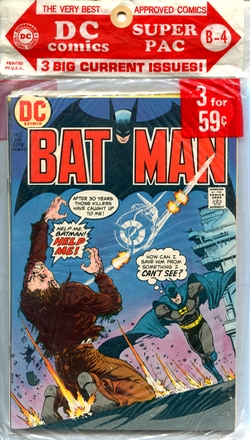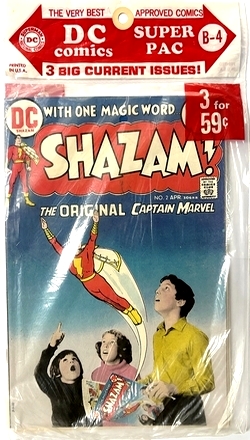 |
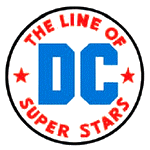 |
|
BATMAN,
LEGION OF SUPER-HEROES &
SHAZAM
BACK
TO BACK IN THE
APRIL
1973 B-4 DC SUPER PAC
|
|
|
|
| |
|
| |
|
| |
|
| |
| In spite of
the hugely successful comeback of the superhero genre in
the early 1960s, the comic book industry had a problem:
its traditional sales points were fading away. Small
stores that had carried comic books were pushed out of
business by larger stores and supermarkets, and
newsagents started to view the low cover prices and therefore
tiny profit margins comics
had to offer as a
nuisance. Comic book
publishers desperately needed to open up new sales
opportunities and and tap into a new customer base. One
place these potential buyers could be found were
supermarkets, chain stores and gas stations - but in
order to be able to sell comic books at these locations,
the product would have to be adjusted. |
| |
| Handling
individual issues clearly was no option for these
outlets, but by looking at their logistics and
display characteristics, DC Comics (who came up
with the Comicpac concept in 1961) found
that the answer to breaking into this promising
new market was to simply package several comic
books together in a transparent plastic bag. This
resulted in a higher price per unit on sale,
which made the whole business of stocking them
much more worthwhile for the seller. The simple
packaging was also rather nifty because it
clearly showed the items were new and untouched,
while at the same time blending in with most
other goods sold at supermarkets which were also
conveniently packaged.
|
|
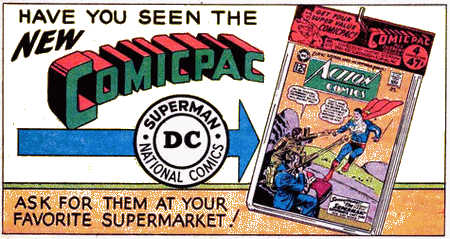 |
|
| |
| Supermarkets were even supplied
with dedicated Comicpac racks, which enhanced
the product appeal even more since the bags containing
the comic books could be displayed on rack hooks in an
orderly and neat fashion. It almost
became an entirely different class of commodity,
and offered parents (and their kids) the opportunity and convenience to pick
up a few comics at the same time they were doing their
general shopping. |
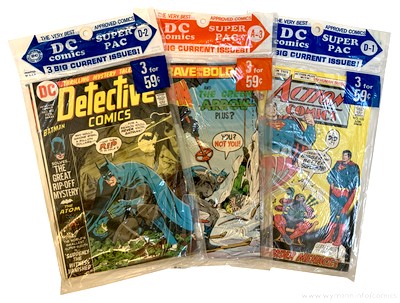
|
|
"DC's focus
[for the Comicpac] was on both the
casual reader and the parents and
grandparents who were looking for
gifts." (Wells, 2012)
DC's
"comicpacks" were a success,
and other publishers quickly started to
copy the concept.
"The
DC [comic packs] program lasted well
over a decade, with pretty high
distribution numbers. The Western
program was enormous - even well into
the '70s they were taking very large
numbers of DC titles for distribution
(I recall 50,000+ copies
offhand)." (Paul Levitz, in
Evanier 2007)
By the early
1970s, DC relaunched their comic packs,
calling them DC Super Pacs, and
they continued to sell well, containing
regular news stand editions.
|
|
|
| |
|
| |
| This April 1973 (B-4) DC SUPER PAC contains Batman #248,
Legion Of Super-Heroes #3, and Shazam #2.
DC handled its multi-comic packs in
a very structured and organised manner; a B-4 pack from a
specific year would carry the same titles and issues no
matter where or when it was sold (rare packaging errors
aside). The digits (1-12) referred to the month and the
letters (A through D) marked the four different packs per
month. "B-4" therefore denotes the second April
SUPER PAC, in this case from 1973, containing comic books
with an April cover date (or April/May in the case of a
bi-monthly title). |
| |
| No
titles had permanent slots in the SUPER PACS, although
there was a high level of consistency with DC's flagship
characters (the SUPER PACs of 1973 contained complete runs
of Superman and Batman as well as the
Batman team-up title Brave and the Bold). But since sales points could vary a
lot with regard to their supplies and selection of SUPER
PACs, the availability of specific titles was never
guaranteed - something many
comic book readers in the 1970s had to put up with,
whether their comic books came packaged in a plastic bag
or as single issues from a display or spinner rack. But
since DC's editorial at large still very much embraced
the "single issue, done in one" storyline
principle during the early 1970s (rather unlike their
major competitor Marvel), it often didn't even matter in
which sequence you read your copies of Batman or
Superman. |
| |
|
| |
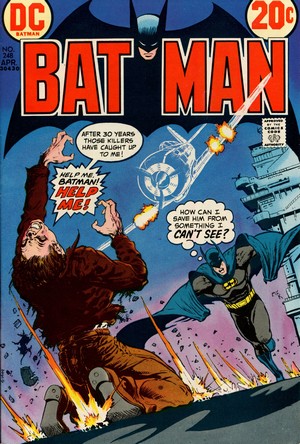
|
|
BATMAN
#248
April 1973
(monthly,
with the exception of Jan., March,
July and Nov.)
On Sale: 13 February 1973
Editor
- Julius Schwartz
Cover - Michael W. Kaluta (pencils &
inks)
Batman: "Death-Knell
for a Traitor!"
(13.5 pages)
Story -
Denny O'Neil
Pencils - Bob Brown
Inks - Dick Giordano
Lettering -
Ben Oda
Robin: "The Immortals
of Usen Castle"
(9 pages)
Story -
Elliott Maggin
Pencils - Irv Novick
Inks - Frank McLaughlin
Lettering -
Milt Snappin
|
|
|
| |
PLOT SUMMARY - Batman
tracks down an ex-Navy man who turned traitor during
World War II for a fabulous diamond; in the end the
traitor falls to his death after reliving the memory of
his ship being attacked by Japanese planes, and the
diamond is lost in the depths of the ocean. Dick Grayson
and Diane Lewis are giving some local youths a tour of a
castle that is supposedly haunted, but when Diana and
some of the children disappear, Dick changes to Robin and
discovers the secret behind the "ghosts" in the
castle.
|
| |
| Over the course of his long
publication history, the Batman has seen many changes
brought to his persona and his adventures. Some took
place gradually, others can be pinpointed to specific
issues - such as Detective Comics #395 (cover
dated January 1970, on sale 22 November 1969). Written by
Dennis O'Neil and drawn by Neal Adams and now a classic
in itself (reprinted in 2000 as one of DC's
"Millennium Editions"), it is often considered
to be Batman’s turning point as the Silver Age crossed
into the Bronze Age and the Darknight Detective returned
to his gothic roots. |
| |

Dennis
"Denny" O'Neil
(1939 - 2020)
|
|
Other writers and artists were
also taking Batman down that path at the time,
but it was O'Neil's compelling concept that hit
home with readers and Batman editor Julie
Schwartz alike, and over the next few years, the
best was yet to come - not the least because
O'Neil had a clear-cut plan.
"The comics
at the time had been trying to follow the
example of the Adam West comedic TV show, and
they weren’t doing a very good job of it
(...) The books were being a bit shaky
sales-wise, as hard as that is to believe,
and Julie [Schwartz] wanted to continue to
publish Batman. So he came to me and asked,
“What have you got my boy?” What I
thought I had, and what I told people I had,
was that we were going back to what Bill
Finger started with in 1939, and we added to
that what the world had learned about telling
stories since then." (O'Neil, in
Handziuk 2019)
|
|
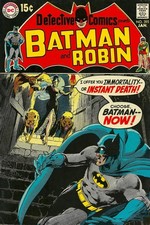
Detective
Comics #395
(January 1970)
|
|
O'Neil was very
methodical about his take on turning the Batman
into a much grimmer, darker
character.
"I went to
the DC library and read some of the early
stories. I tried to get a sense of what Kane
and Finger were after." (O'Neil, in
Pearson & Uricchio 1991)
Ultimately,
this also resulted in underscoring the
investigative side of the Batman's persona -
effectively creating the Darknight Detective.
"There was
very little consistency. Sometimes he was a
detective, sometimes he was more a superhero.
When I took over the franchise I said okay,
this is the way we do it. Batman comics will
be about superhero stuff with a lot of
action, and Detective Comics is about the
same character functioning as a
detective." (O'Neil, in Handziuk
2019)
As a result, Batman and
Detective Comics took two entirely
different routes: whereas the latter title now
only featured plain clothes thugs and evil-doers,
Batman retained the costumed villains.
One significant and very noticeable aspect both
titles did share was a string of eye-catching
(and sometimes outright iconic) covers.
"The Batman
covers, whether they were [by Neal Adams] or
the odd ones that Mike Kaluta did during that
period, were set-pieces way above, I think,
most of the rest." (Levitz, in
O'Neil, Adams, Levitz & Evanier 2011)
|
|

Michael W. Kaluta (*1947)
|
|
Michael
William Kaluta (sometimes credited as
Mike Kaluta or MW Kaluta) pencilled and
inked three Batman and eight Detective
Comics covers between 1972 and 1974,
all of which convey a unique feel for the
iconic qualities of Gotham's Caped
Crusader. His cover for Batman
#248 (his first being for issue #242 and
his third and last for issue #253) is a
prime example of his ability to evoke and
capture the atmosphere surrounding the
Batman. |
|
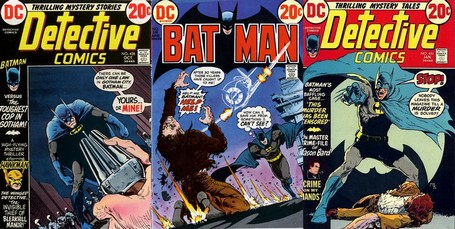 |
|
|
| |
| The story told by Denny O'Neil in Batman
#248 - a "done in one" adventure that starts
and concludes in the same issue, as per the standard
formula still favoured by DC at the time - features
Colonel Sulphur as the costumed villain (after first
appearing in Batman #241). A decidedly
derivative "international criminal" (this would
be the last readers would see of him until he would
resurface for four brief stints in World's Finest
and Brave and the Bold in the early 1980s), he
is essentially watching from the sidelines as Batman
trails a former WW2 traitor in cahoots with the Colonel.
The plot has a few interesting psychological themes, but
it's thanks to the artwork of Bob Brown that Batman
#248 comes off as a marvelous piece of early 1970s Batman
lore. |
| |
| Brown started his career in comic books
in the 1940s, and did regular work for DC and
Marvel in the early and mid-1970s, including
almost 40 issues of Batman in Detective
Comics between 1968 and 1973 - but only this
one issue of Batman. Like many
other veteran contributors at DC Comics in the
early 1970s, Brown increasingly found his work to
be labelled as "old-fashioned"
(Evanier, 2004) - but his artwork for Batman #248 clearly
shows otherwise.

Throughout
this issue Brown's images have a wonderfully
dynamic flow to them (that car trying to hit the
Batman is leaving the panel boundaries and coming
straight at you), but his "silent" page
7 is a masterpiece. Very conservative in its
panel composition, the visuals are not only
stunning and telling the story without the need
for words but also feature (Neal Adams inspired)
iconic Batman vignettes. It just doesn't get any
better - and yet neither Batman #248
specifically nor Bob Brown in general have left
much of a mark in Batman's publication history.
|
|
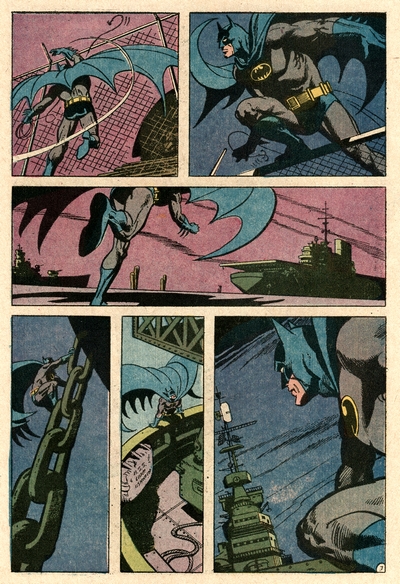 |
|
| |
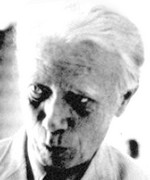
Bob Brown
(1915-1977)
|
|
Later in 1973,
Brown left DC for Marvel, and
that was that. He died four years
later from leukemia. Few Batman aficionados
will be able to tell you that
(together with writer Deny
O'Neil) he created the Caped
Crusader's first encounter with
the League of Assassins (Detective
Comics #405, November 1970) and
co-created the character Talia,
the daughter of Ra's al Ghul and
subsequently a recurring romantic
interest for Batman (Detective
Comics #411, May 1971).
"lt’s
somewhat unfortunate that
Adams’ undeniably dynamic
work on Batman towers over
his Bat-contemporaries.
Fortunately, Irv Novick, Jim
Aparo, and Frank Robbins (as
artist) have garnered due
recognition over the years.
Not so with Brown, however,
which is a shame, because his
pencil work on [Batman #248],
inked by Dick Giordano, is
outstanding."
(Kingman, 2011)
|
|
|
|
| Batman
#248 only contains a cut-down
letters page, due to the fact that one
third of the page is taken up by the
"Statement of ownership, management
and circulation". The postal services
had required a published statement of
ownership since the 19th
Century from all publications that were
shipped Second Class, but as of 1960
publishers were also required to list
their average circulation for the year.
Most readers at the time gave these
numbers only a cursory glance (if at
all), but today they allow us an easy
glimpse into print runs and sales of that
era.
|
|
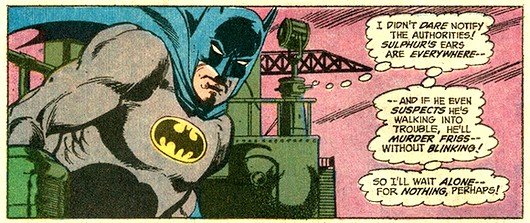 |
|
|
| |
| As far as Batman was
concerned, the numbers were down compared with the
average of the preceding 12 months: 404,000 copies
printed (compared to the average 478,125), of which
185,283 copies in paid circulation (244,488). However,
sales figures of Batman would recover and
increase for 1973 and 1974, before going on a sliding
trajectory which saw the number of issues sold on average
dip below 100,000 in 1983/84. |
| |

|
|
As was
typical for the early 1970s, the
attrition rate in terms of distributed
but unsold copies was terrible: totals of
201,414 (nearest to the filing date) or
185,283 (average of the preceding 12
months) meant that practically half of
the print run never made DC any money -
and the same applied to comic book
publishers across the board. The problem was
caused by the traditional distribution
model with returnability - which
essentially meant that the loss incurred
by unsold copies was on the publishers,
not the distributors or sales points. Not
surprisingly, it was a breeding ground
for an attitude of "we couldn't care
less" when it came to actually
selling the product.
"A
few retailers actually liked carrying
comics, but most were indifferent
(...) So, let’s say [the local
distributor] actually delivered 5,000
copies [of 10,000 received at the
warehouse] to the retailers - if they
bothered to deal with unwrapping and
sorting, if they had room on the
trucks… Most likely, they’d only
actually deliver comics to retailers
who would complain if they didn’t
get comics and places that sold
enough comics to make the driver’s
effort worthwhile."
(Shooter, 2011)
|
|
|
| |
Another huge problem were the
fraudulent practices it attracted.
"We [at Marvel]
actually found a company that was sending back more
copies than we shipped them. We found out there was a
printer in Upstate New York that was printing copies
of our covers to sell back to us (...) At the time we
had something like a 70 percent return rate"
(Galton in Foerster, 2010)
It all became completely untenable
by the time the 1970s rolled around and triggered the
impetus for the creation of "comic packs" such
as DC's Super Pacs and the direct market.
|
| |
| As the 1970s rolled
around, Batman would either
feature a 20+ pages single or two shorter
stories involving the Caped Crusader,
before the second story slot began
featuring Robin as of Batman
#227 (December 1970). As of issue #230
(March 1971) the cover logo even featured
Robin's name before reverting back to
the long-established logo as of Batman
#241 (May 1972), but still featuring
Robin ("the Teen Wonder") as
backup (with the odd exception for an
issue or two publishing a longer Batman
story). This
arrangement would last until Batman
switched to DC's "pages Super
Spectacular" format as of issue #254
(January/February 1974), which then
featured multiple reprints including
Robin "the Boy Wonder"
(incidentally, that format also precluded
Batman being included in any
Super-Pac from January 1974 to March
1975)
|
|
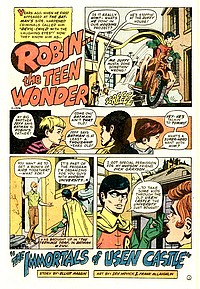 |
|
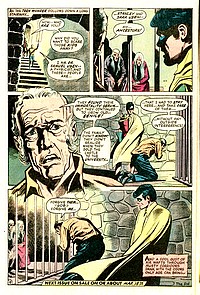 |
|
|
| |

Elliott Maggin
(*1950)
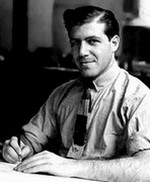
Irv Novick
(1916-2004)
|
|
The Robin back-up
story featured in Batman
#248 was the third of only seven
scripts penned by Elliott S.
Maggin featuring the Teenage
Wonder (appearing in Batman
#244, #245, #248-250, #252 and
#254). Known primarily for his
work on Superman, his Robin plots
feature interesting twists and
involve deep and far-reaching
topics - such as, in the case of
"The
Immortals of Usen Castle",
that immortality may come at the
price of suffering from eternal
old age and growing dementia. In
that respect, Maggin was often
somewhat ahead of his time when
it came to subject matters
infused into comic book stories.
| |
|
|
| Paired
with Maggin for the
artwork was classic
Bronze Age artist Irv
Novick (inked by Frank
McLaughlin), delivering
his reliably dynamic
pencils - and another
(almost)
"silent" page,
with plenty of action
over a total of six
panels but only one
speech balloon, one
thought balloon, and two
"sound
effects"... 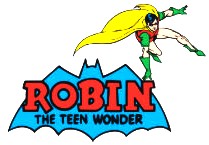
|
|
 |
|
|
|
|
| |
| |
|
| |
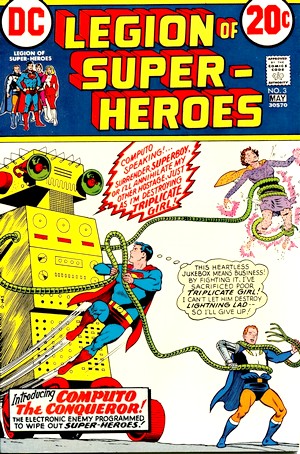
|
|
LEGION OF
SUPER-HEROES #3
April/May
1973
(bi-monthly)
On Sale: 13 February 1973
Editor - Jeff
Rovin
Cover - Curt Swan (pencils) &
George Klein (inks)
LEGION
OF SUPER-HEROES: "Computo
the Conqueror!" (16
pages)
Story
- Jerry Siegel
Pencils - Curt Swan
Inks - George Klein
reprinted
from Adventure
Comics #340 (January 1966)
TOMMY
TOMORROW:
"The Trial of Tommy
Tomorrow" (6
pages)
Story
- Otto Binder
Pencils & Inks - Jim Mooney
reprinted from Action
Comics #240 (May 1958)
PLOT
SUMMARIES
- Brainiac 5's latest creation
turns on its master and the rest
of the Legion; Tommy Tomorrow is
put on trial for murder.
|
|
|
|
| |
| Comic book sales had been in a
steady decline since the 1950s (when top-selling issues
still enjoyed print runs of around or above 1 million
copies), but by the time the 1970s rolled around the
dropping sales figures meant that the only way to make
more money was to make sure you got a bigger slice of the
(shrinking) market - and one way to achieve that was to
put out more titles. And since the space at the sales
point was not going to increase, you could at the same
time push the competition off the shelves. Marvel was
the comic book industry's number one, but until mid-1972
DC still published more titles - until Marvel launched
the "war of the shelves" through a
proliferation of titles.
"[Marvel]
did flood the market, but remember, this was that
period (...) where Marvel suddenly decided to put out
a whole bunch of books (...) trying to get market
share (...) lots of stuff came out in the '70s
because of this approach." (Roy Thomas, in
Cooke 2001)
DC realized what was happening, and Carmine Infantino,
DC's publisher since 1971, tried to stem the tide in 1973
by emulating Marvel and putting out a few new (Shazam,
Prez, Plop) as well as some reprint titles in order
to boost DC's output and keep from getting pushed off of
those shelves. Unfortunately, the success of both
offerings was somewhat underwhelming, and most of the
reprint titles only saw a handful of issues before being
cancelled.
|
| |
But there was a logic to the
failure of the DC reprint titles launched in 1973
- the Silver Age material they featured simply
wasn't hitting home with current readers any more
- and Infantino knew it.
"The DC books
were very sterile-looking in those
days." (Infantino & Spurlock,
2001)
However, in terms of overall sales figures,
however, DC didn't fare that badly. In 1973,
Marvel roughly sold a total of 6.5 million comic
books, with DC at 5.5 million copies. But the
comic book industry as a whole was struggling and
in a downward spiral; by 1975 Marvel lost $2 million a year (Daniels,
1991), whilst DC's business returns were in the
red for $1 million. Although doing only half as
badly as Marvel, Infantino was fired by the
Warner Brothers top brass (Howe, 2012).
|
|

Carmine
Infantino
(1925 - 2013)
|
|
| |
| Legion of Super-Heroes
was the very first of the 1973 reprint titles, launched
with a February cover date, and at least initially (for
the first two issues) supplied with new covers by Nick
Cardy. |
| |
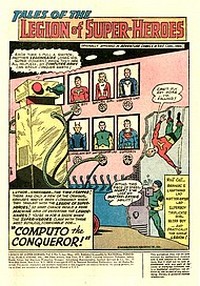
|
|
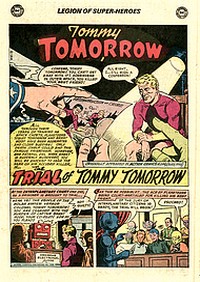 |
|
Its main feature
- no surprise, given its title - was material
starring the Legion of Super-Heroes which had
previously been published between 1964 and 1966
in Adventure Comics (with stories from Action
Comics dating from 1957/58 added for the
final two issues). Legion of Super-Heroes
switched from monthly to bi-monthly publication
after two issues, before ceasing publication all
together after a mere four issues.
Although these were mostly newer
stories from less than ten years ago (and
therefore pretty much what Marvel was repackaging
in its superhero reprint titles), the problem was
that this 1960s material featured stories and
artwork with heroes (e.g. Matter-Eater Lad) and
villains (e.g. Computo the Conqueror) that had
more of a 1950s feel to them. That is presumably
what the majority of comic book readers in 1973
felt too, given the extraordinary short life-span
of this title.
|
|
| |
 |
|
Only
the two final issues of Legion
of Super-Heroes were
packaged into DC's
SUPER-PACs of 1973 (B-4
and B-6). |
|
|
|
|
| |
| |
|
| |
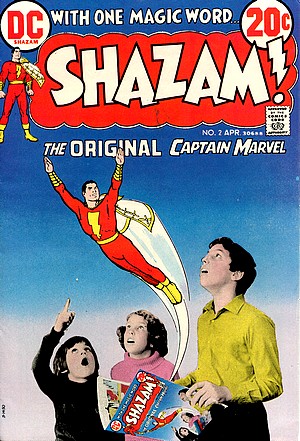
|
|
SHAZAM #2
April
1973
(monthly, with the
exception of Jan., March, July
and Nov.)
On Sale: 15 February 1973
Editor -
Julius Schwartz
Cover - C.C. Beck (pencils &
inks) & Jack Adler
(photograph & assemblage)
SHAZAM:
"The Astonishing Arch
Enemy" (10 pages)
Story - Denny O'Neil
Pencils, Inks, Lettering - C.C.
Beck
SHAZAM:
"The Nicest Guy in the
World" (7 pages)
Story - Elliot Maggin
Pencils, Inks, Lettering - C.C.
Beck
SHAZAM:
"The
Original Captain Marvel Fights
Niatpac Levram!"
(6 pages)
Story - Otto Binder
Pencils, Inks, Lettering - C.C.
Beck
(reprinted from
Captain
Marvel Adventures #139,
December 1952)
|
|
|
|
| |
| PLOT
SUMMARIES -
Mr. Mind destroys a museum to get his
glasses back from it and then plans to destroy the United
States but is stopped by Captain Marvel with the help of
the Saint Louis Arch, which he uses as a tuning fork;
Bank robbers give Sunny Sparkle their loot; Wizzo uses
magic to animate Captain Marvel's mirror image in an
attempt to become a master magician. |
| |
|
| |
| As editorial director Carmine
Infantino was gearing up DC for a slew of reprint titles
to hit the spinner racks in 1973 in order to try and push
back Marvel's numerical and therefore visual and
commercial dominance at comic book points of sale, it was
obvious that DC also needed new titles if there was to be
any chance of competing with their mighty rival. |
| |
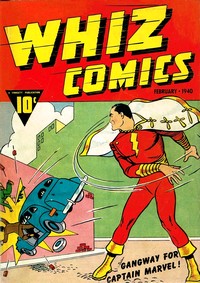
Whiz
Comics #2
(February 1940)
|
|
One
such title launched in early 1973 was Shazam!
- although "new" wasn't exactly
accurate in this case, as DC decided to license
the original Captain Marvel from Fawcett and
bring him back after a publication hiatus of
nearly 20 years - a move full of irony since it
had been DC who had put an end to the character's
adventures (and indeed Fawcett's entire line of
superhero comics) in the courts by 1954, claiming
- not without reason if you compared the covers
of Action Comics #1 and Whiz Comics
#2) - that Captain Marvel was ripping off
Superman. Unable to use the original title
since Marvel had gained the copyright to the name
back
in 1967, DC went with the magic word that
transforms adolescent radio
news reporter Billy Batson into the
"World's Mightiest Mortal". A
"continual drumbeat" from fans for the
character's return along with a built-in fanbase
(Sacks, 2014) seemed too good an opportunity to
be missed, and DC went all out in hyping up the
retrun of Captain Marvel in Shazam
(officially the title came with an exclamation
mark).
|
|
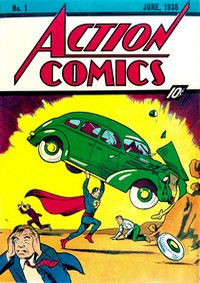
Action
Comics #1
(June 1938)
|
|
| |
Assigned veteran editor Julius Schwartz added another
coup to the launch by bringing on the original
artist, Charles Clarence (C.C.) Beck, giving DC’s
revival an added boost of credibility - and even more
publicity (Smith, 2010). This move also settled other
matters:
"The question we had
at the time was whether we should do what they had
before and see if it worked. They decided to go that
route, and promoted the hell out of it!"
(Elliot Maggin in Smith, 2010)
|
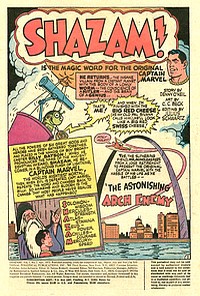 |
|
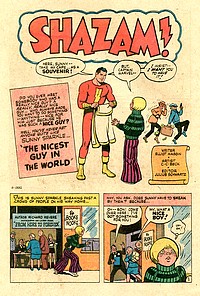 |
|
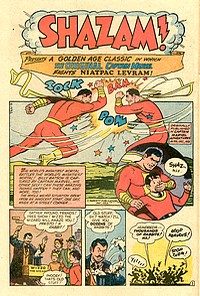 |
|
In essence, this meant an
entirely retro take on both visuals and
storylines, meaning simple and almost cartoony
artwork along with just as quirky - and often
over the top - plots. Shazam
#2 featured two original stories and one reprint,
and even though the latter was from 1952, they
were almost impossible to tell apart.
This combination spoke to
older fans (who knew the original material) and
very young readers, but held little appeal to
most regular comic book readers.
|
|
"It was an
anachronism (...) The audiences were in a process of
getting older quicker. The more successful comic
books were beginning to adapt to that, to cater to
that college-age audience and older. And I think
Captain Marvel got caught in the wrong age at the
wrong time, and it was not working for the people who
were buying comic books." (Michael Uslan in
Smith, 2010)
|
| |
| Shazam sold well
initially, but before long sales dropped precipitously
(Sacks, 2014). Matters were further complicated by C.C.
Beck's interference in the creative process, leading to
frustration amongst writers (who saw their script changed
without notice) and ultimately also with editor Julius
Schwartz. |
| |
"The
conflict between Beck and the
other creators reached a
boiling point when he refused
to draw the scripts for
[Shazam #10] (...) At Nelson
Bridwell’s suggestion, Beck
did his own story (...)
Bridwell’s [subsequent]
rewrites to the script didn’t
sit well with Beck, and he
washed his hands of the
book." (Smith,
2010)
DC had
enough, and Beck was out. As of
issue #12 (May 1974), Shazam
was reduced to a bi-monthly
publication schedule,
periodically only featured
reprints, and was finally
cancelled in May 1978 with issue
#35. During all of that time,
Beck was essentially at war with
the contemporary creators and
publishers of comic books, as can
be seen from a list of
"seven deadly sins of comics
creators" which he had
jotted down in the 1980s and were
featured in Alter Ego (Vol.
3) 36 (Hamerlinck, 2000). Beck
stipulates that comic book
artwork should be visually simple
("Billy Batson and
Captain Marvel were drawn in
cartoon-comic style because they
appeared in comic books")
|
|
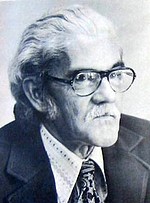
C. C. Beck
(1910-1989)
|
|
|
|
| |
| Beck advocated (and quite
uncompromisingly so) that comics should stick to their
roots, and voiced a clear distaste for artists who went
beyond the conventionalities established in the 1930s and
1940s ("artists who show people bursting out of
their panels and leaping off the pages are destroying the
illusion that the reader is seeing an exciting story
unfolding itself on the printed page"). He had
a distinctly old school approach to comic books - and
unfortunately for him, that just didn't sell anymore. |
| |
| |
 |
|
DC's
(initial) drive to push Shazam
any which way they could
can also be felt in their
SUPER-PACs of 1973 and
1974, where the title was
included frequently,
starting with Shazam
#1. |
|
|
|
|
| |
|
| |
| There were many things that set
DC apart from Marvel in the early 1970s, but one very
salient aspect was DC's lack of any regular editorial
feature across its titles through which editors would
communicate with their readership (as Marvel and Stan Lee
did with their famous Bullpen Bulletins); DC's
interaction with its fans and readers was limited to the
letters pages, whilst plugs for other titles were
essentially restricted to in-house ads. If you picked up
this April 1973 B4 SuperPac, you came across the
following. |
| |
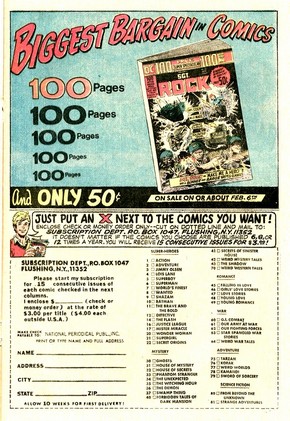 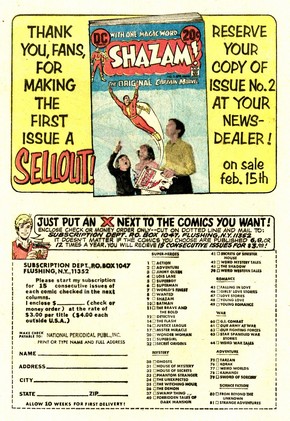 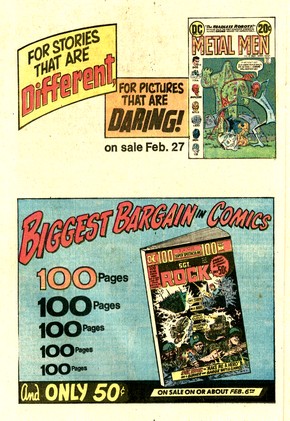
Left from Batman
#248, center & right from Legion of Super-Heroes
#3
|
| |
|
| |
| FURTHER
READING ON THE THOUGHT
BALLOON |
| |
| |
 |
|
"Comic
packs" not only sold well
for more than two decades, they
also offer some interesting
insight into the comic book
industry's history from the 1960s
through to the 1990s. There's
more on their general history here. |
|
|
|
| |
 |
|
An overview
and analysis of all the 1973
Super Pacs is available
here. |
|
|
|
| |
 |
|
You can read
more about the 1973 "war of
the shelves" between Marvel
and DC here. |
|
|
|
| |
|
| |
BIBLIOGRAPHY
| |
| COOKE
Jon
B. (2001) "Son of Stan: Roy's Years
of Horror", in Comic Book Artist #13 DANIELS
Les (1991) Marvel: Five
Fabulous Decades of the World's Greatest Comics,
Harry N. Abrams
EVANIER
Mark (2004) "On
the Passing of Bob Haney", News From
Me, published online 7 December 2004
EVANIER Mark (2007)
"More on Comicpacs", News From Me,
published online 2 May 2007
FOERSTER Jonathan
(2010) "Marvel Comics' miracle
man set up business' success", Naples Daily
News, 30 May 2010
GREENFIELD
Dan (2024) "13
Reasons Batman Artist Bob Brown Deserves More
Credit", 13th Dimension,
published online 5 March 2024
HAMERLINCK
P.C. (2000) "The
Seven Deadly Sins of Comics Creators, by C.C.
Beck", Alter Ego (vol. 3) #6,
TwoMorrows Piublishing
HANDZIUK Alex
(2019) "An
Interview with Legendary Creator Denny O'Neil -
The father of Modern Day Batman", cgmagonline.com,
published online 16 March 2019
HOWE Sean
(2012) Marvel Comics - The Untold Story,
Harper Collins
INFANTINO Carmine,
with J. David Spurlock (2001) The Amazing
World of Carmine Infantino. An Autobiography,
Vanguard
KINGMAN
Jim (2011) "What Bob Brown did for
Batman", Back Issue #50, TwoMorrows
Publishing
O'NEIL
Denny, Neal Adams, Paul Levitz & Mark Evanier
(2011) "Pro2Pro: Dark Rebirth", Back
Issue #50, TwoMorrows Publishing
PEARSON
Roberta E. & William Uricchio (1991)
"Notes from the Batcave: An Interview with
Dennis O'Neil", in The Many Lives of the
Batman: Critical Approaches to a Superhero and
His Media, Routledge
SACKS
Jason (2014) American Comic Book
Chronicles: The 1970s (1970-1979),
TwoMorrows Publishing
SHOOTER Jim (2011)
"Comic Book Distribution", jimshooter.com,
published online 15 November 2011
SMITH
Zack (2010) "An
Oral History of Captain Marvel: The Shazam Years,
pt1", newsarama.com, published
online 31 December 2010 (accessed through
Internet Archive)
WELLS
John (2012) American Comic Book Chronicles:
The 1960s (1960-1964), TwoMorrows Publishing
|
|
| |
|
| |

|
| |
|
| |

(c) 2025
The illustrations
presented here are copyright material. Their
reproduction for the review and research purposes
of this website is considered fair use as set out
by the Copyright Act of 1976, 17
U.S.C. par. 107.
uploaded to the web
17 August 2025
|
| |
|
| |
|


